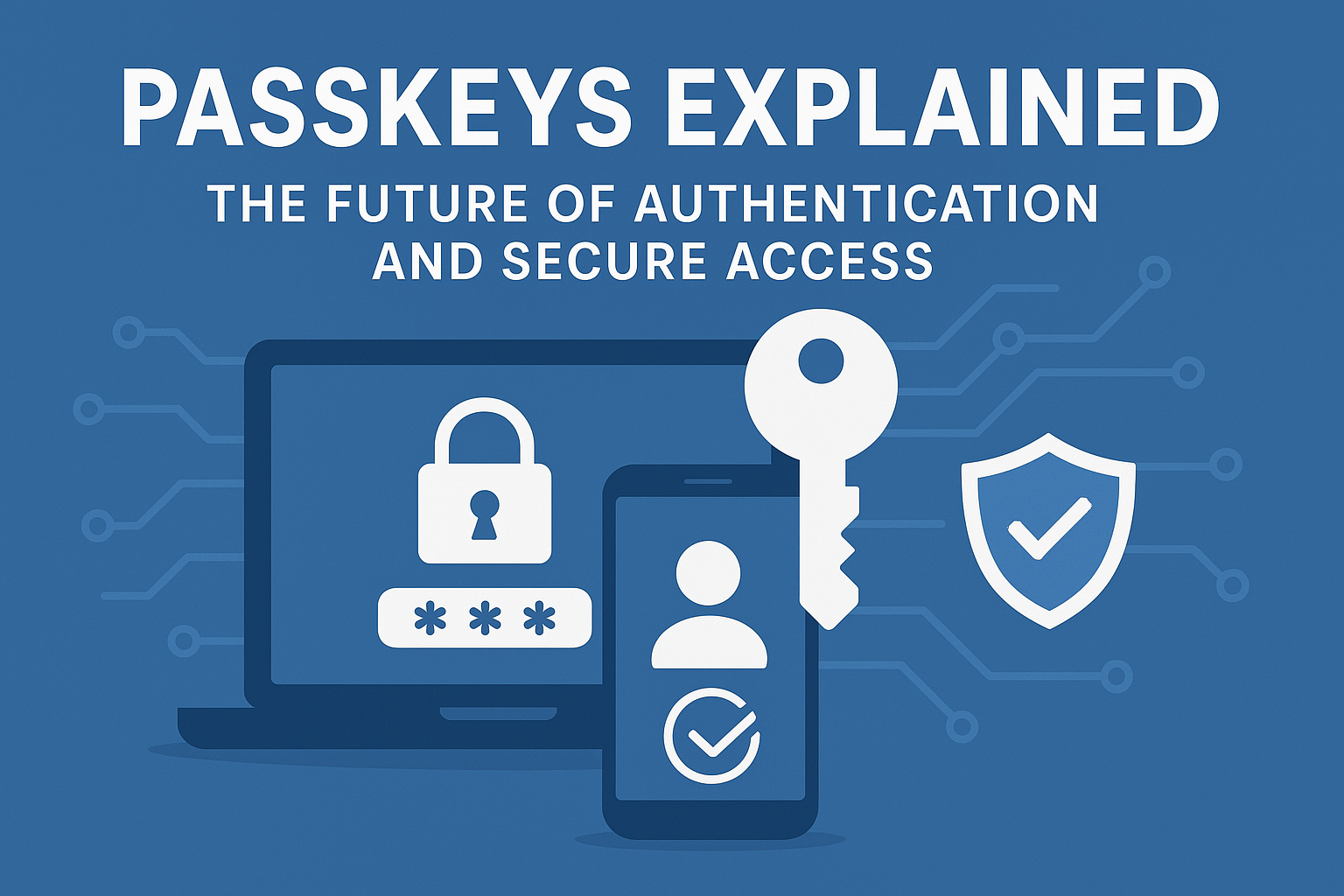In an era where digital security is paramount, traditional authentication methods like passwords are rapidly being challenged by newer, more secure alternatives. One of the most promising innovations is passkeys, which aim to replace passwords with a simpler and more secure method of verifying identity. Passkeys leverage modern technology to provide both ease of use and enhanced protection, reducing the risk of breaches and streamlining the authentication process. This article explores what passkeys are, how they work, and why they are poised to become the future of digital authentication.
What Are Passkeys?
Passkeys are a form of passwordless authentication that eliminates the need for users to remember or input passwords. Instead of a conventional password, a passkey uses cryptographic key pairs, biometric data, and device-based security measures. Passkeys rely on unique identifiers stored on a user’s device, such as a smartphone or computer, which can only be accessed through secure biometric verification, like a fingerprint or face scan, or a device PIN.
Unlike traditional passwords, which are vulnerable to phishing and brute-force attacks, passkeys are designed to be more secure and user-friendly, offering a seamless way to log in without the need to remember complex passwords.
Why Passkeys Are Gaining Popularity
Passkeys are gaining attention because they address two major issues: security and usability. Passwords have long been a weak point in cybersecurity, with common passwords often compromised by cyberattacks. Furthermore, remembering complex passwords and regularly resetting them creates friction for users. Passkeys offer a solution by combining security with ease of access, making authentication more convenient and secure. As cyber threats increase, passkeys are being embraced by both users and organizations as a safer and more practical alternative.
How Do Passkeys Work?
Passkeys operate through a system of cryptographic key pairs: a public key and a private key. The private key is stored securely on a user’s device, such as a phone, laptop, or tablet. When a user attempts to log into a service, the service sends a challenge to the device, which is signed by the private key. This signed challenge is then verified by the service using the public key, allowing access without the need to input a password.
This process typically includes an additional layer of security, such as biometric verification (like a fingerprint or face ID) or a device PIN. Because the private key never leaves the device, passkeys provide a high level of security while allowing users to authenticate quickly and conveniently.
Passkeys vs. Passwords: Key Differences
Passkeys differ from traditional passwords in several ways. First, passkeys are more secure, as they are resistant to common attacks like phishing, brute-force, and credential stuffing. Since the private key is stored on a specific device and cannot be shared or stolen as easily as a password, this makes passkeys a highly secure option. Additionally, passkeys streamline the user experience, removing the need to remember, reset, or type in passwords repeatedly. Overall, passkeys offer a simpler and safer alternative to conventional passwords.
The Benefits of Using Passkeys
- Enhanced Security: Passkeys offer stronger protection than passwords, as they use device-based verification and biometric data to prevent unauthorized access.
- User Convenience: With passkeys, there’s no need to remember complex passwords or perform frequent resets. Users can log in with a biometric scan or PIN, streamlining access.
- Cost Reduction: For businesses, passkeys reduce the need for password management and related support, lowering IT costs and enhancing security.
These advantages make passkeys an attractive solution for both individuals and organizations looking to strengthen their digital security.
How Passkeys Protect Against Common Cyber Threats
Traditional passwords are vulnerable to various attacks, including phishing, credential stuffing, and brute-force methods. Passkeys address these threats effectively(assuming there are no fallback to vulnerable methods). Since they use a device-specific private key that never leaves the device, they are resistant to phishing attempts, as attackers cannot replicate the device key. Passkeys also prevent credential stuffing because there is no static password to be reused across multiple sites. This robust approach to security significantly reduces the risks posed by common cyber threats.
Industry Adoption of Passkeys
Some of the world’s largest tech companies, including Apple, Google, and Microsoft, are leading the way in adopting passkeys. By integrating passkeys into their ecosystems, these companies are setting a standard for secure, passwordless authentication. Passkeys are also aligned with FIDO (Fast IDentity Online) standards, a global standard for passwordless authentication. Industries such as finance, healthcare, and e-commerce are beginning to adopt passkeys as part of a comprehensive approach to security.
How to Set Up and Use Passkeys as a User
Setting up passkeys is straightforward for most users. On supported devices, users can create a passkey by setting up biometric verification, such as a fingerprint or face scan, or by using a secure PIN. Once set up, passkeys can be used across multiple applications and services that support passkey login. Users only need to ensure their devices are secure, as losing a device with stored passkeys could pose a risk.
Are There Any Drawbacks to Using Passkeys?
Despite their advantages, passkeys are not without challenges. One potential drawback is dependency on device security. If a device with passkeys is lost or compromised, access to accounts protected with passkeys may be possible as all the passkeys could be retrieved. Compatibility across platforms can also be an issue, as not all services support passkeys yet. In addition, most platforms that support passkey still fallback to a vulnerable method for authentication. Hence, the security of passkey is as good as the fallback methods.
The Role of Passkeys in the Future of Digital Authentication
Passkeys represent a significant advancement in digital authentication, offering an alternative to traditional password-based security. In the coming years, we can expect passkeys to become more prevalent as they are integrated with other security innovations, such as multi-factor authentication and zero-trust architecture. The widespread adoption of passkeys is expected to make digital authentication more secure and user-friendly.
How Businesses Can Transition from Passwords to Passkeys
For businesses, transitioning to passkeys involves several steps. Companies need to update their systems to support passkey login, educate employees and customers on using passkeys, and assess the cost benefits of reduced password management. By adopting passkeys, businesses can offer a higher level of security to their users, reduce the burden of password resets, and ultimately enhance their cybersecurity posture.
Passkeys Key Facts
- Can passkeys be used on multiple devices?
- Yes, passkeys can often be synced across devices using secure methods, such as cloud storage linked to the user’s account.
- Are passkeys completely secure from hackers?
- While no security method is 100% foolproof, passkeys are resistant to phishing and brute-force attacks due to their cryptographic foundation.
- How do passkeys align with privacy regulations?
- Passkeys support privacy by design, as they do not require users to store or share sensitive information like passwords.
- What should I do if I lose the device with my passkey?
- Most passkey systems offer recovery options, such as using a secondary device or account recovery settings.
- Are passkeys compatible with all apps and websites?
- Currently, not all platforms support passkeys, but adoption is growing, especially with major tech companies leading the way.
Conclusion
Passkeys represent the future of secure, user-friendly authentication, promising an era where users no longer need to rely on passwords to access their digital accounts. By using device-specific cryptographic keys and biometric data, passkeys eliminate many of the vulnerabilities associated with traditional passwords. As more organizations and individuals adopt passkeys, we can look forward to a more secure and streamlined digital experience. Transitioning to passkeys can help reduce security risks, lower IT costs, and simplify the user experience: making them an essential innovation in the future of digital authentication.


